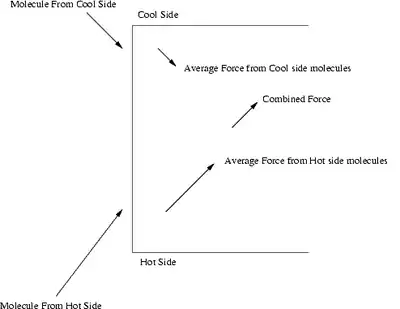
Diagram showing pressure difference induced by a temperature difference.
Thermal transpiration (or thermal diffusion) refers to the thermal force on a gas due to a temperature difference. Thermal transpiration causes a flow of gas in the absence of any other pressure difference, and is able to maintain a certain pressure difference called thermomolecular pressure difference in a steady state. The effect is strongest when the mean free path of the gas molecules is comparable to the dimensions of the gas container.
Thermal transpiration appears as an important correction in the readings of vapor pressure thermometers,[1][2] and the effect is historically famous as being an explanation for the rotation of the Crookes radiometer. [3] [4]
See also
- Knudsen pump — a gas pump with no moving parts which functions via thermal transpiration.
- Thermophoresis (Soret effect) — diffusion of colloidal particles in a liquid, induced by a temperature gradient.
References
- ↑ Watkins, R. A. (1967). "Thermomolecular Pressure Difference Measurements for Precision Helium−3 and Helium−4 Vapor-Pressure Thermometry". The Journal of Chemical Physics. 46 (3): 1007–1018. Bibcode:1967JChPh..46.1007W. doi:10.1063/1.1840762.
- ↑ Pobell, F. (2007). Matter and Methods at Low Temperatures (3rd ed.). Springer. ISBN 978-3-540-46356-6.
- ↑ Reynolds, Osbourne (1879). "On certain dimensional properties of matter in the gaseous state. - Part I. Experimental researches on thermal transpiration of gases through porous plates and on the laws of transpiration and impulsion, including an experimental proof that gas is not a continuous plenum. - Part II. On an extension of the dynamical theory of gas, which includes the stresses, tangential and normal, caused by a varying condition of gas, and affords an explanation of the phenomena of transpiration and impulsion". Philosophical Transactions of the Royal Society of London. 170 (170): 727–845. doi:10.1098/rstl.1879.0078.
- ↑ Maxwell, James Clerk (1879). "On stresses in rarified gases arising from inequalities of temperature". Philosophical Transactions of the Royal Society of London. 170: 231–256. doi:10.1098/rstl.1879.0067. S2CID 110911902.
This article is issued from Wikipedia. The text is licensed under Creative Commons - Attribution - Sharealike. Additional terms may apply for the media files.